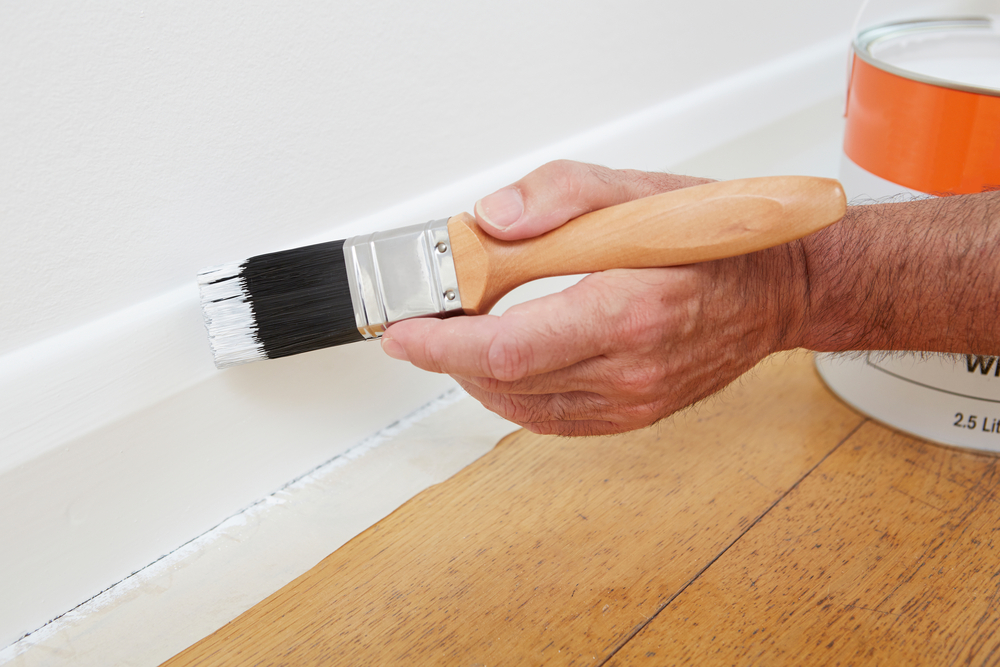
We all love doing some painting in our free time. Whether it is a full room transformation or just a quick freshen up, there’s nothing more satisfying than taking a step back and admiring our handiwork.
But there are a few painting jobs that are easy to avoid. You step back to admire your interior walls and see that your skirting boards need some attention too. Ignore them and they’ll stick out like a sore wooden thumb.
Today we’re going to talk about how to get the most out of your skirting boards; explaining the best paint for the job and a detailed guide on how to get the best finish.
Should I Paint Skirting Boards?
Painting your skirting boards is crucial if you want your rooms to look their best. Replacing them is costly, so a fresh coat of paint that will cover up the scuffs, stains, and imperfections that can ruin the look of your walls.
It’s often best to paint your skirting boards before your walls. This is because the paint you’ll use for walls is easier to clean and remove than the thicker paint that suits skirting and trim.
You can also apply an acrylic undercoat to your skirting boards to help the outside layer last longer. This water-based product makes the surface easier to paint and can also help cover any imperfections in the wood surface.
What Colour should I Paint Skirting Boards?
When choosing the colour for your skirting boards, you have two choices. You can either paint them the same colour as your walls, allowing them to blend in, or paint them a different colour to stand out or complement the colour scheme.
Painting them the same colour suits some walls, although they can still stick out from certain angles and not look great. We recommend trying the colour on an inconspicuous area first to see how it looks. You’ll also need to buy a different type of paint in the same colour, which can be tricky (unless you use Paintmaster’s colour system!).
If you choose the latter option, white is the most common colour. It works alongside both light and dark colour schemes and can make your walls look bolder by comparison.
In some modern properties, skirting boards are a thing of the past, so your walls flow seamlessly from floor to ceiling. This saves the job of having to paint skirting boards entirely, just be careful with the vacuum cleaner!

The Best Paint for Skirting Boards
Even if you’re careful when cleaning, our skirting boards suffer a lot of wear and tear over the years. The paint you use for them needs to be hardwearing, so it takes longer for them to look tired and dirty. Even something as simple as a layer of dust at the top of skirting boards can ruin them over time if you use any old can of acrylic or emulsion.
The best types of paint are:
- Oil-Based paint
- Gloss Paint
- Satin Paint
- Acrylic Paint
Oil-based and gloss paint is naturally thicker than other types of paint and has a range of sheen options. You’ll notice a slight shine to most painted skirting boards, which is a sign that they were painted with gloss or oil-based paint.
Our oil-based satinwood paint has a lower sheen level than other types, giving it a matte finish. We also have an oil-based gloss that is durable, lasting for years even on surfaces that suffer a lot of wear and tear.
Finally, as with every painting project, there is an acrylic option. Available in stock colours or as part of our Colour System, with which we can mix your paint to be any colour you need, so there’s no more worrying about if the shades will match. If you also use our acrylic undercoat, you’ll get even bolder colours that will look great for a long time.
When choosing your paint, trade-quality is the way to go. Paintmaster is one of the UKs most trusted suppliers of trade paint, with a wide range of products available in large quantities to suit bigger projects.
How to Paint Skirting Boards
Giving your skirting boards a fresh coat of paint is a simple process. It’s also one of the few projects where primer is not needed unless the surface has never been painted.
Here is everything you’ll need for the best results:
- Paint
- Paint Brush
- Masking Tape
- Sandpaper
- Old towels/sheets
STEP 1 – Preparation
Cover the base of the skirting boards with the old towels or sheets to protect your carpets and floors. Try to use enough that you can do an entire wall at a time.
Remember, the paint you use can be tough to remove once it’s dry, be ready to clean any splashes.
Cover the top of your skirting with masking tape, a line or two is plenty. This will protect your walls and give you professional-looking sharp lines.
STEP 2 – The First Layer
Mix your paint and cover the top of the skirting board with an even layer. This is known as cutting in. Cover the entire length of the wall so you won’t have to blend in a new layer with one that’s already dry.
Next, fill in the rest of the skirting with paint. Try not to overload the brush, you want as little runoff as possible.
STEP 3 – Sanding
Once the first layer is dry, use your sandpaper to gently rub away any drips or imperfections in the paint.
STEP 4 – The Second Layer
Once the surface is even, apply the second layer in the same way as before. Overlap your brush strokes for a streak-free finish.
Two layers of paint should be plenty, but don’t be afraid to add a third if you want extra protection.
STEP 5 – Admire your Work
Once the final layer has dried, slowly remove the masking tape and towels/sheets, and take a step back to admire your freshly painted skirting boards.
How do they look? If you have any paint left after you’ve painted all your skirting boards, save it for any future touch-ups.
The UK’s Most Trusted Paint Supplier
Painting skirting boards is a simple job, but it’s important to get it right. Trust Paintmaster to guide you through the process and provide you with the best paints, primers, and painting accessories you need. We specialise in high-quality products that will help you get the results you want.
If you have any questions about any of our products or want to learn more about interior and exterior painting, either get in touch or check out our blog for more information.
We look forward to hearing from you.
FAQ's
Do you paint skirting boards with a brush or roller?
A small foam roller is the best tool for long skirting boards, ensuring an even coverage every time. But you should also use a paint brush for any indentation or edging that the paint roller can’t reach.
How do you prepare already painted skirting boards?
Before you apply a fresh coat of paint, you need to clean the surface as thoroughly as possible, as well as removing any flaking paint and marks using a fine-grit sandpaper.
How many coats of paint on skirting boards?
We recommend 2 coats of paint for skirting boards. This will ensure the colour and sheen stand out, and the surface will be protected for years. If they still look streaky, a third layer should create a faultless finish.
Should you paint skirting boards gloss or matt?
It’s common to paint skirting boards with a glossier finish. Paint that is designed for skirting boards often has a higher sheen than most paints, as it adds more protection from scuffs and scratches. But if you prefer a matte finish, there are plenty of options available.
Should you paint skirting or walls first?
If you are decorating a room, we recommend painting your skirting after your walls. This means that any paint splashes or drips from your walls can be covered up, which is sometimes unavoidable even if you use masking tape.
